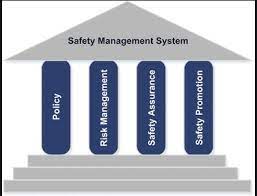Title Page
-
Site conducted
-
Conducted on
-
Prepared by
-
Location
Safety Policy and Objectives
Management Commitment and Responsibility
-
SOUND: Is there a safety policy that:
-
Reflects management’s commitment to safety?
-
Includes a clear statement about providing necessary resources?
-
Includes safety reporting procedures?
-
Is signed and dated by the Accountable Executive (AE)?
-
Is communicated, with visible endorsement, throughout the organization?
-
Indicates which types of behaviors that are unacceptable?
-
Includes the conditions under which exemption from disciplinary action would be applicable?
-
Is periodically reviewed to ensure it remains relevant and appropriate to the organization?
-
APPROPRIATE
-
Is the safety policy relevant to the scope and complexity of the organization’s operations?
-
Is everyone aware of the safety policy?
-
EFFECTIVE
-
Is the safety policy reinforced by day-to-day decisions?
-
Is everyone committed to enhancing safety performance?
-
Is there visible evidence of management demonstrating by example?
Safety Accountabilities
-
SOUND: Does the SMS documentation identify the AE and the safety responsibilities, accountabilities, and authorities of all personnel, to include a definition of the levels of management with authority to make
decisions regarding safety risk tolerability? -
APPROPRIATE
-
Do the AE’s terms of reference indicate his/her ultimate responsibility for the SMS?
-
Are there clear lines of safety accountabilities throughout the organization?
-
EFFECTIVE
-
Are the resources available to manage risks effectively?
-
Does everyone know their role in the SMS and participate accordingly?
Appointment of Key Safety Personnel
-
SOUND: Does the SMS documentation include an appointment of a safety manager?
-
APPROPRIATE
-
Is the safety manager properly trained?
-
EFFECTIVE
-
Are the results of safety management activities formally recorded and analyzed?
-
Coordination of ERP
-
SOUND: Does the SMS documentation include an ERP that is properly coordinated with the emergency response plans of those organizations it must interface with during the provision of its services?
-
APPROPRIATE
-
Is there a procedure for periodic review of the ERP to ensure its continuing relevance and effectiveness?
-
EFFECTIVE
-
Is the ERP regularly tested and updated including coordination with other organisations as appropriate?
SMS Documentation
-
SOUND: Does the SMS documentation include:
-
A plan that defines the organization‘s approach to meet the safety objectives
-
Safety policy and objectives
-
SMS requirements
-
SMS processes and procedures
-
Accountabilities, responsibilities and authorities for processes and procedures
-
SMS outputs
-
APPROPRIATE
-
Is the SMS documentation readily available to ALL personnel?
-
EFFECTIVE
-
Is there evidence that the SMS documentation is regularly reviewed and updated?
-
Does the documentation provide evidence that safety objectives are being met?
Safety Risk Management
Hazard Identification
-
SOUND: Is there a formal process to ensure hazards are identified using
the following methods -
Reactive?
-
Proactive?
-
Predictive?
-
APPROPRIATE
-
Is there a reporting system to capture errors, hazards and near misses that is simple to use and accessible to all personnel?
-
Is there a procedure to review hazards/risks from external reports?
-
EFFECTIVE
-
Are hazards, errors, near misses, and audit findings being identified and reported throughout the organization?
-
Are employees confident they can report apparent safety deficiencies without retribution?
-
Are both internal and external information used to update the safety risk profile?<br>
-
Is there a procedure for periodic review of existing risk analysis records?
Risk Assessment and Mitigation
-
SOUND: Is there a formal process for to manage safety risks that includes:
-
Analysis?
-
Assessment?
-
Control?
-
APPROPRIATE
-
Does the AE and management team have visibility of medium and high risks and their controls?
- Yes
- No
- N/A
-
Do training programs highlight safety critical issues identified in the safety risk profile?
-
Does the Ops Manual contain mitigation described in the safety risk profile?
-
EFFECTIVE
-
Does the organization use its risk management results to develop best practices?
-
Is the information indicating the need to change respected, valued, validated, and used?
-
Is there consistent feedback to encourage the future participation of managers and employees?
-
Is the Operations Manual consistently employed by operational managers and staff?
-
Does mitigation take into account Human Factors and Organizational Factors
Safety Assurance
Safety performance monitoring and measurement
-
SOUND: Is there a process and/or procedure to:
-
Validate the effectiveness of the safety risk controls?
-
To established safety performance indicators and targets?
-
APPROPRIATE
-
Has the organization developed a series of safety performance indicators that are appropriate to the type of operation?
-
Are safety indicators and targets specific, measurable, agreed to, relevant and time-based?
-
Is the information from occurrences analyzed and where appropriate, used to upgrade policies and procedures?
-
Are priorities regularly reviewed, reassessed and, if required, reassigned to address safety issues?
-
EFFECTIVE
-
Are safety targets being achieved?
-
Is there a means to measure and monitor trends and take appropriate action when necessary?
-
Have the controls for the safety risks been evaluated?
-
Are the results from internal audits used to measure safety performance?
Management of Change
-
SOUND: Is there a process to identify and manage organizational changes that may affect safety?
-
APPROPRIATE
-
Are stakeholders involved in the change management process?
-
Are there procedures for managing the revisions of documents, manuals, and checklists?
-
Are changes to critical documents communicated throughout the organization?
-
EFFECTIVE
-
Does the organization use the SMS to proactively assess all major changes to the organisation and its operations
-
Do staff members always use up-to-date documents, manuals, checklists, and/or procedures?
Continuous Improvement
-
SOUND: Is there a process or procedure to ensure continuous improvement of the SMS?
-
APPROPRIATE
-
Is there an internal audit/assessment process and a follow-up procedure to address audit findings?
-
EFFECTIVE
-
Is there evidence of improvements to policies, procedures, and/or processes based on internal audit findings?
Safety Promotion
Training and Education
-
SOUND: Has the organization developed and maintained safety training programs that ensure that personnel are competent to perform their SMS duties?
-
APPROPRIATE
-
Does training include human and organisational factors with the intent of reducing human error?
-
Does technical training (i.e. pilot, maintenance, dispatch/scheduling, etc.) reinforce SMS principles (i.e. human factors, organizational factors, risk assessments, risk management, etc.)?
-
EFFECTIVE
-
Is there evidence that all personnel involved in SMS operations have undergone appropriate SMS training?
-
Are executives, managers, and staff capable of performing their roles to proactively manage safety?
Safety Communication
-
SOUND: Has the organization developed and maintained a formal means of safety communication?
-
APPROPRIATE
-
Are significant events and investigation outcomes from internal and external sources communicated to all personnel?
-
EFFECTIVE
-
Is there evidence that all personnel are aware of the SMS, safety critical information, and their role in respect of aviation safety?
Compliance Monitoring
-
Has the operator established and maintained a system for identifying applicable regulations, standards, approvals, and exemptions and demonstrated compliance with them?
Flight Data Analysis
-
Has the organization established a flight data analysis program <br>(Recommended Practice)














